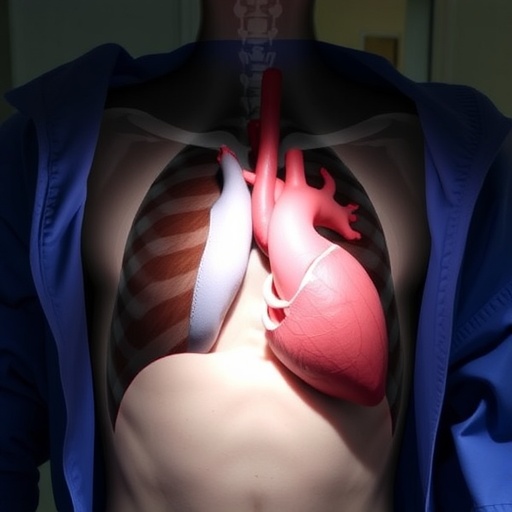In recent years, advancements in cardiac support technologies have provided new hope for patients suffering from severe heart conditions. One groundbreaking approach gaining traction in the medical community is the use of extracorporeal biventricular support systems, allowing for improved patient outcomes during critical periods of heart failure. This significant medical development is especially relevant for individuals awaiting heart transplants or those for whom traditional surgical options pose a formidable risk.
A primary focus of this recent study led by experts including Yamamoto, Yajima, and Kawamura is the implementation of extracorporeal biventricular support via left mini-thoracotomy. This innovative technique presents a minimally invasive alternative to conventional surgical methods, granting medical professionals the ability to provide life-saving support with reduced trauma to the patient’s body. Not only does this approach enhance patient comfort, but it also diminishes recovery times, which is essential in critical care settings.
During the research, the team highlighted the intricacies involved in setting up a biventricular support system. It is vital for clinicians to ensure optimal positioning and integration of the device to facilitate proper management of both the left and right ventricles. The success of this approach increases the likelihood of successfully bridging patients to potential heart transplantation or achieving spontaneous recovery during the acute phase of heart failure.
The methods utilized in this study significantly diverge from traditional surgical protocols, emphasizing the use of a left mini-thoracotomy access point. By opting for this less invasive entryway, the researchers aimed to reduce the overall trauma associated with heart support procedures. As a result, patients not only experience decreased pain levels but also benefit from shorter hospital stays, improving overall patient management.
Moreover, the efficacy of extracorporeal biventricular support lies in its versatility. This system has the potential to be adapted for various patient needs, offering customized solutions for individuals depending on their specific heart conditions and clinical circumstances. The study meticulously documents how device specifications can be altered according to the severity of heart failure and individual anatomical differences.
Another crucial aspect of this research is the evaluation of the support system’s performance over extended periods. Previous support devices often encountered limitations regarding durability and effectiveness during prolonged usage. However, the team’s findings suggest that with ongoing monitoring and appropriate adjustments, the extracorporeal biventricular support system demonstrates sustained performance, thereby representing a promising route for long-term patient management.
Furthermore, the emotional and psychological toll experienced by patients with advanced heart disease cannot be overlooked. The ability to provide robust temporary support while reducing the surgical burden offers not just physical relief but potentially enhances the overall emotional well-being of patients hopeful of recovering from their condition. This comprehensive approach is what makes the findings of this study particularly noteworthy.
In light of the outcomes observed during the research, the authors stress the importance of multidisciplinary collaboration in managing patients on extracorporeal support. The integration of cardiologists, surgeons, pharmacists, and nursing staff comes together to provide an optimal environment for patient recovery, underscoring the progress being made in cardiac care.
As the medical field continues to evolve, further studies building upon the findings of Yamamoto and colleagues are essential. Continued exploration of new technologies and techniques may unearth additional benefits and applications that could transform the landscape of cardiac surgery and heart failure management.
The impressive advance of extracorporeal biventricular support through left mini-thoracotomy exemplifies how innovation can lead to improved patient care. With research like this paving the way, the future looks promising for individuals facing dire heart conditions. The intersection of technology and compassionate care has the potential to save lives, redefine the surgical approach to heart failure, and inspire further innovations in the years to come.
In conclusion, the intricacies of this groundbreaking study highlight the need for thorough understanding and dissemination of new cardiac support systems. As practitioners in the field continue to adopt and refine these techniques, the hope remains that such innovations will be integral in addressing the challenges associated with heart failure. The possibility of bridging patients to recovery or transplant is a testament to the tireless efforts of medical professionals striving to enhance the quality of care in the face of adversity.
The study’s implications are poised to resonate throughout the field for years to come, encouraging continued dialogue, research initiatives, and educational efforts focused on the ongoing challenges of heart disease. Indeed, the evolution of biventricular support systems serves as a potent reminder of the human spirit’s unwavering quest for progress in medicine and patient care.
Subject of Research: Extracorporeal biventricular support through left mini-thoracotomy
Article Title: Extracorporeal biventricular support through left mini-thoracotomy
Article References:
Yamamoto, M., Yajima, S., Kawamura, T. et al. Extracorporeal biventricular support through left mini-thoracotomy.
J Artif Organs 29, 5 (2026). https://doi.org/10.1007/s10047-025-01538-3
Image Credits: AI Generated
DOI: https://doi.org/10.1007/s10047-025-01538-3
Keywords: Extracorporeal support, biventricular support, heart failure, minimally invasive surgery, cardiac care innovations.
Tags: advancements in cardiac support technologiesbiventricular support system integrationbridging patients to heart transplantationcritical care cardiac supportextracorporeal biventricular support systemsheart failure management strategiesinnovative surgical approaches for heart conditionsleft thoracotomy techniquesminimally invasive cardiac surgerypatient comfort in cardiac carerecovery times in heart surgeryreduced trauma surgical options





